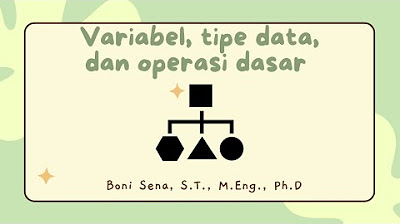AULA 06 OPERAÇÕES BÁSICAS 001
Summary
TLDRIn this tutorial, Carlos Futin introduces the fundamentals of programming, focusing on data manipulation through basic operations. He explains key operators in various programming languages such as Python, Java, and C. Topics covered include arithmetic operations (addition, subtraction, multiplication, division), relational operators (equality, greater than, less than), and other language-specific features. The lesson highlights how different languages handle operations like division, remainder, and exponentiation. It provides a comprehensive look at operators across languages, helping students understand the nuances in handling data and performing basic calculations in code.
Takeaways
- 😀 Programming operations are essential for manipulating data in a program, modifying the values stored in variables during execution.
- 😀 Operators are symbols that indicate operations on variables or values, and different programming languages implement different sets of operators.
- 😀 Python supports more operations than basic arithmetic, including operations like integer division and modulo, which can give remainders from divisions.
- 😀 Unlike Python, Java and C do not support built-in exponentiation, and their syntax for operations like division differs from Python.
- 😀 In Python, operators like ** (double asterisks) are used for exponentiation, unlike other languages like Java and C.
- 😀 Arithmetic operators include addition, subtraction, multiplication, division, and some languages may have additional ones like integer division or power.
- 😀 Python performs implicit type conversion in arithmetic operations, such as turning integer divisions into floats automatically.
- 😀 C and Java perform integer division automatically when both operands are integers, while Python requires a specific operator for integer division.
- 😀 Relational operators compare two values and return boolean results. Python, Java, and C all support operators like '==', '!=', '>', '<', '>=', and '<=' for comparisons.
- 😀 Java requires explicit type declarations for variables (e.g., int, boolean), while Python does not require variable type declarations.
- 😀 Students are encouraged to engage with supplementary materials on the platform, including quizzes and forum discussions, for further learning.
Q & A
What is the main topic of the lesson in the video?
-The main topic of the lesson is the use of basic operations in programming, specifically focusing on mathematical and relational operators in various programming languages like Visualg, Python, Java, and C.
What are operators in programming languages?
-Operators in programming languages are symbols that perform operations on variables or values. They are used to manipulate data and are represented by specific symbols or keywords depending on the programming language.
What are the main types of operators discussed in the lesson?
-The main types of operators discussed in the lesson are mathematical (arithmetic) operators, relational operators, and logical operators. The lesson particularly focuses on arithmetic and relational operators.
How do mathematical operators work in programming?
-Mathematical operators perform basic arithmetic operations like addition, subtraction, multiplication, and division. These operators manipulate numerical values stored in variables. For example, in Visualg, you can perform operations like x = x + y, where the value of x is updated by the result of x + y.
What is a key difference between Visualg and Python in terms of operator implementation?
-A key difference is that Visualg does not handle floating-point division well for integer variables, while Python automatically converts to floating-point numbers when performing division. Python also has additional operators like the floor division (//) and modulo (%) operators.
Why did Python handle the division differently than Visualg?
-Python automatically handles division by converting the result to a floating-point number, even when both operands are integers. In contrast, Visualg requires you to be mindful of data types, especially with integer division.
What is the purpose of the power operator (**) in Python?
-The power operator (**) in Python is used to calculate exponents. For example, 5 ** 3 will return 125, which is 5 raised to the power of 3. This operator is unique to Python among the languages discussed in the lesson.
How do relational operators differ from arithmetic operators?
-Relational operators are used to compare two values and return a boolean result (true or false), whereas arithmetic operators perform mathematical calculations on values. Relational operators include equality (==), inequality (!=), greater than (>), and less than (<), among others.
What happens when you use the '==' operator in programming?
-The '==' operator checks if two values are equal. It returns true if the values are equal and false if they are not. For example, in Python, 3 == 3 would return true, while 3 == 5 would return false.
Why is it important to declare the correct variable type when performing operations?
-It is important to declare the correct variable type to ensure that the operations are performed correctly. For example, if you try to divide two integers without specifying that the result should be a floating-point number, the operation may not give the expected result. Some languages, like Java and C, may perform integer division by default unless explicitly stated.
Outlines

This section is available to paid users only. Please upgrade to access this part.
Upgrade NowMindmap

This section is available to paid users only. Please upgrade to access this part.
Upgrade NowKeywords

This section is available to paid users only. Please upgrade to access this part.
Upgrade NowHighlights

This section is available to paid users only. Please upgrade to access this part.
Upgrade NowTranscripts

This section is available to paid users only. Please upgrade to access this part.
Upgrade NowBrowse More Related Video

Introduction to SQL/1

What Linear Algebra Is — Topic 1 of Machine Learning Foundations

Informatika Analisis Data Pengenalan Bahasa Phyton Pada Google Collab Perintah print dan array

C_08 Variables in C Programming | C Programming Tutorials

23. Literasi Digital - Rumus dan Fungsi Dasar pada Excel - Informatika Kelas X

Variabel, tipe data dan operasi dasar
5.0 / 5 (0 votes)